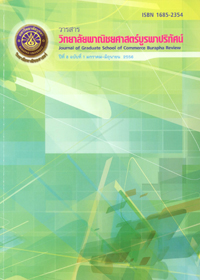ประสิทธิผลของการใช้กลยุทธ์สื่อสารการตลาดแบบบูรณาการ: ประกันชีวิตใน สปป.ลาว (นครหลวงเวียงจันทน์)
Main Article Content
Abstract
การวิจัยนี้มีวัตถุประสงค์เพื่อศึกษาและเปรียบเทียบการรับรู้การสื่อสารการตลาดแบบบูรณาการ และวิเคราะห์ผล ของปัจจัยส่วนบุคคลที่มีผลต่อการรับรู้การสื่อสารการตลาดแบบบูรณาการ กลุ่มตัวอย่างได้แก่ประชาชนในสปป. ลาว (นครหลวงเวียงจันทน์) จำนวน 400 คน เครื่องมือวิจัยที่ใช้คือ แบบสอบถามที่ผู้วิจัยสร้างขึ้น โดยผ่านเกณฑ์การตรวจสอบ ความเที่ยงตรงเชิงเนื้อหาจากผู้ทรงคุณวุฒิ และผลการทดสอบเครื่องมือมีค่าความเชื่อมั่นของแบบสอบถามเท่ากับ 0.98 การวิเคราะห์ด้วยโปรแกรมสำเร็จรูป สถิติที่ใช้ได้แก่ ค่าความถี่ ค่าร้อยละ ค่าเฉลี่ย ส่วนเบี่ยงเบนมาตรฐาน และเปรียบเทียบ ค่าเฉลี่ยของการรับรู้การสื่อสารการตลาดแบบบูรณาการโดยใช้ t-test และการวิเคราะห์ความแปรปรวนแบบทางเดียว (One –way ANOVA) ทดสอบความแตกต่างรายคู่ด้วย LSD และวิเคราะห์ผลของปัจจัยส่วนบุคคลที่มีต่อการรับรู้การสื่อสาร การตลาดแบบบูรณาการด้วยการวิเคราะห์ถดถอยพหุคูณ (Multiple Regression Analysis)
ผลการวิจัยพบว่า กลุ่มตัวอย่างที่มี เพศ อายุ และสถานภาพสมรสแตกต่างกัน มีการรับรู้การสื่อสารทางการตลาด แบบบูรณาการ และประสิทธิผลของการใช้สื่อสารการตลาดแบบบูรณาการแตกต่างกันอย่างไม่มีนัยสำคัญ ทางสถิติ แต่เมื่อจำแนกตามระดับการศึกษา และรายได้เฉลี่ยของครอบครัว พบว่า มีการรับรู้การสื่อสารทางการตลาดแบบบูรณาการ และประสิทธิผลของการใช้สื่อสารการตลาดแบบบูรณาการแตกต่างกันอย่างมีนัยสำคัญทางสถิติที่ระดับ .05
ปัจจัยที่มีผลต่อประสิทธิผลของการใช้การสื่อสารการตลาดแบบบูรณาการอย่างมีนัยสำคัญทางสถิติ ประกอบด้วย 8 ปัจจัย ได้แก่ การโฆษณา การส่งเสริมการขาย การจัดอีเวน การประชาสัมพันธ์ การตลาดทางตรง การตลาดออนไลน์ การตลาดแบบปากต่อปาก และการขายโดยบุคคล โดยสามารถอธิบายความผันแปรของการสื่อสารการตลาดแบบบูรณาการ ได้ร้อยละ 47.9 โดยเขียนเป็นสมการพยากรณ์ในรูปคะแนนมาตรฐานได้ดังนี้ Z = 0.145 (X1)* + 0.153 (X2)* + 0.161 (X3)* + 0.187 (X4)* + 0.125 (X5)* + 0.208 (X6)* + 0.034 (X7)* + 0.185 (X8)*
EFFECTIVENESS OF INTEGRATE MARKETING COMMUNICATION (IMC) STRATEGIES FOR LIFE INSURANCEVIENTIANE CAPITAL LAOS PDR
Pattamanun Hirunteerawat, Suchonee methiyothin, Nappadon Dejprasert and Sawitree Bintasan
Graduate School of Commerce, Burapha University, Chon Buri 20131, Thailand
This research has the objectives to study and compare the integrated marketing communication perception and to analyze the effect of demographics on the integrated marketing communication perception. The samples are 400 people in Vientiane, Laos PDR. The research tool is questionnaire that the researcher developed by herself which passed the content validity test from experts, and had a reliability value of 0.98. Data were analyzed with a software package. Statistics used include frequency, percentage, mean, standard deviation, t-test, One-way ANOVA with LSD, and multiple regression analysis.
This study finds that people with differences in gender, age, and marital status have different integrated marketing communication perception and integrated marketing communication effectiveness, but not statistically significant. However, people with differences in education and average family income have statistically different integrated marketing communication perception and integrated marketing communication effectiveness at the .05 level of significance.
Factors that significantly affect the effectiveness of integrated marketing communication usage are these eight factors; advertising, promotion, event marketing, public relation, direct marketing, on-line marketing, word-of-mouth marketing, and personal selling. These eight factors can explain 47.9% of the variation in the integrated marketing communication, and can be written in standard score equation form as follows; Z = 0.145 (X1)* + 0.153(X2)* + 0.161(X3)* + 0.187(X4)*+ 0.125(X5)* + 0.208(X6)* + 0.034(X7)* + 0.185(X8)*.
Article Details
The owner of the article does not copy or violate any of its copyright. If any copyright infringement occurs or prosecution, in any case, the Editorial Board is not involved in all the rights to the owner of the article to be performed.


